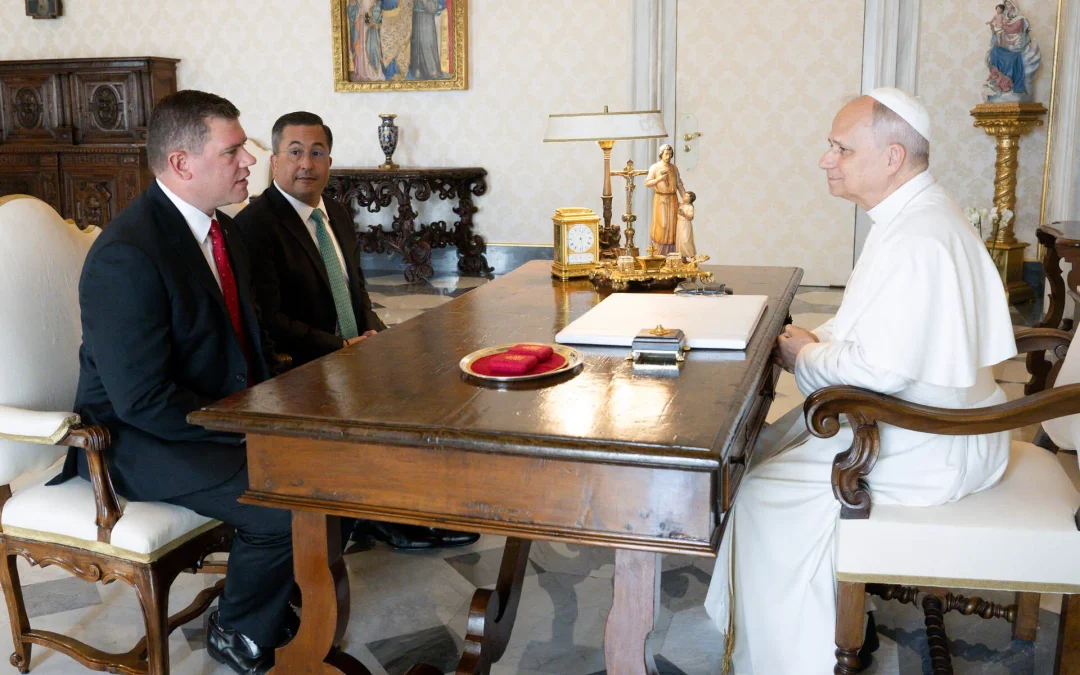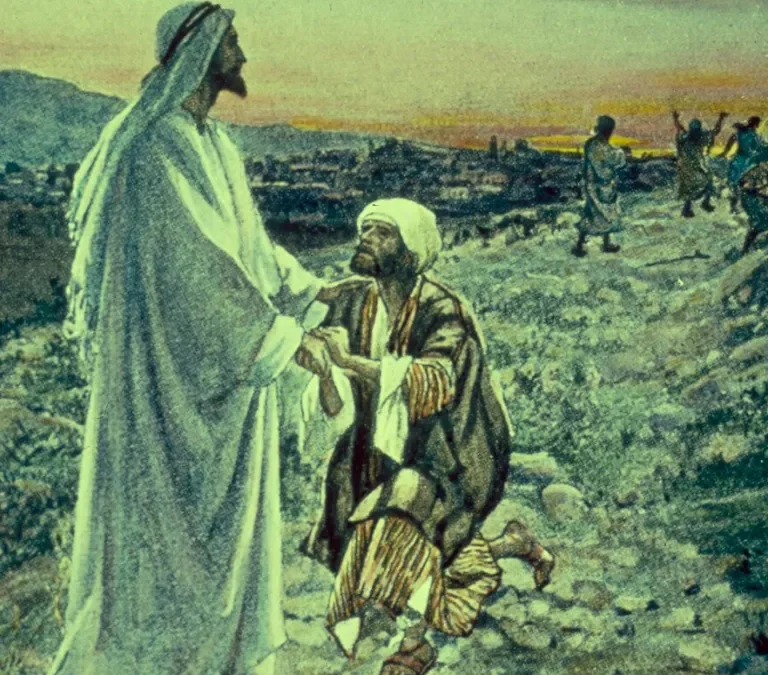“If anyone wishes to come after Me, he must deny himself and take up his cross daily and follow Me. For whoever wishes to save his life will lose it, but whoever loses his life for my sake will save it.” – Luke 9:23-24
Stories are often told about the great and the consequential, but God tends to work through the most ordinary to bring about his Kingdom. Holiness sustained and lived out in everyday life is not always flashy, but it is powerful. This is particularly true in the life, ministry, and martyrdom of Blessed Stanley Rother, a man from Oklahoma who took up his cross daily and became one of our age’s greatest witnesses to the love of Christ.
Who is Blessed Stanley Rother?
Formation
Stanley Rother’s childhood was, by all accounts, remarkably unremarkable. He was the oldest of four siblings and grew up on a farm in Okarche, Oklahoma. His family was one of many of German descent in the area and also one of many that had belonged to Holy Trinity Catholic Church for generations. He played basketball.He was an altar server. He spent most of his early mornings milking cows. In high school, he had been the president of the Future Farmers of America. Everyone assumed he would continue to work on his family’s farm after graduation. Stanley shocked his friends and family by announcing his intention to enter the seminary.
Despite the surprise of his discernment, Stanley’s years in priestly formation at Assumption Seminary in San Antonio, Texas were otherwise as normal as his childhood. In addition to classes, communal prayer, and other obligations, he often worked outdoors, fixed machinery, and tended to the seminary grounds. He struggled with academics, however, especially with Latin, mastery of which was required for candidates to the priesthood. In his sixth year of formation, he was dismissed from the seminary because of his poor grades. He returned home and worked on his family’s farm for several months but never lost sight of his vocation. He knew that God was calling him to the priesthood.
He worked with his Bishop to find a way to continue with formation. After intensive Latin courses, he continued his studies at Mount St. Mary’s Seminary in Emmitsburg, Maryland. He was never a ‘star student,’ but he passed his classes. He was ordained to the priesthood in 1963. Father Stanley was assigned as a Parochial Vicar in several parishes around the state. Even as a priest, he was still called upon to help the Diocese with manual work, clearing forests and building cabins for what became a Diocesan retreat center on Lake Texoma!
Mission
The year 1968 was a crucial turning point for Father Stanley. The Diocese took on the Holy Father’s call to support missions in Latin America by establishing and staffing a mission in Santiago Atitlán, Guatemala. Father Stanley, ever close to the promptings of the Spirit, answered the call to minister at the mission.
He was not a scholar, he was not a linguist, and he was not particularly well-versed in Mayan culture. But he was willing to go. He joined the mission’s team in the rural highlands of Guatemala, and it became clear that he was precisely the person they needed.
This priest with a heart for the Eucharist was also a skilled farmer and machinist. He helped develop co-ops, taught the community new farming techniques, and completely revitalized the starving local economy. The quiet boy from rural Oklahoma became a friend, brother, and father to the long-abandoned indigenous community scattered throughout the mountains.
The man of prayer was also an outspoken advocate for his flock. He hosted the elderly for lunch at his rectory, often feeding them by hand. This man who had been sent home from seminary for failing Latin became fluent in Spanish and Tz’utujil: an isolated Mayan dialect that had never been written down. Indeed, Father Stanley would eventually direct the project to not only develop a Latin-based writing system for the language but also to translate the New Testament into Tz’utujil. He built a radio station, a convent, and a hospital and recruited or trained people to run them. Father Stanley developed teams of catechists, celebrated sacraments, and brought together a parish, pastorless for centuries, under the wings of the Church. He was so beloved by the community that they addressed him with a Tz’utujil name: Padre Apla’s.
Martyrdom
Throughout the 70’s, Guatemala’s ongoing civil war escalated and drew closer to Santiago Atitlán. People disappeared, both sides recruited civilian spies, and the government occupied the village. Most of the international missionaries left until Father Stanley was the only missionary remaining.The sisters he had brought in, the catechists he had trained, and eventually his parochial vicar aided him greatly. Because Father Stanley knew the local language and continued to minister to his people, he became a target. In 1980, his name appeared on a death list, and he came home at the urging of his then-Archbishop.
While back safely in Oklahoma, Father Stanley knew he could not stay. Through much prayer, he again heard the voice of Jesus, telling him that the shepherd cannot run and abandon his flock when there is danger. He returned to Santiago Atitlán just in time for Holy Week of 1981. The threats continued to escalate, and he was urged many more times to leave the country for his safety.He stood firm in his dedication to his people.
In the early morning hours of July 28, 1981, three masked men forced their way into the rectory and shot Father Stanley. The community was devastated. After his funeral in their parish church, the people agreed to send his body back to be buried in Oklahoma- so long as they were able to bury his heart. To this day, while his remains have been moved several times and now rest in the Blessed Stanley Rother Shrine in Oklahoma City, his heart remains with his people in Santiago Atitlán.
Cause
The Archdiocese of Oklahoma City opened his cause for canonization in 2007. In 2017, Father Stanley Rother was declared a martyr and beatified, making him Blessed Stanley Rother. This is the last step of the process before canonization when he would be declared a Saint.
Advancing a cause for canonization can take an incredibly long time. The Church, in her wisdom, requires a thorough evaluation of the life of a person to ensure that they are an example that ought to be held up before the world. Martyrdom takes the place of one miracle in the process, which is why he was beatified only 36 years after his death. One verifiable miracle through Blessed Stanley’s intercession since 2017 is required for his canonization.
The current Archbishop of Oklahoma City, Archbishop Paul Coakley, likes to remark that for Blessed Stanley to be canonized, “It’ll take a miracle!” That phrase is commonly a sign of desperation, but for the Church, it’s a reality we can reasonably anticipate.
Lessons from Blessed Stanley
There are many lessons to be learned from the life and death of Blessed Stanley Rother. We can note how much he accomplished through hard work. We can marvel at his persistence and courage. We can appreciate his dedication: first to his vocation, then to the reality of living it out. The aspect of his witness that most often inspires me is how normal he really was. He wasn’t a straight-A student. He wasn’t wealthy or famous. He was a normal kid in a rural community. Now we are close to honoring him as a saint.
He is also very close to me personally: he was an American, he grew up a few hours from my hometown, he spoke English, and if not for his martyrdom, he might very well still be alive today. The stories of all the saints are inspiring and incredible, but there’s something special about having photographs of a saint, or videos, or knowing that the siblings of a saint are still alive. As moving and amazing as the stories of all the saints are, I feel particularly compelled by the recency and similarity of Blessed Stanley, as well as others on the path to sainthood who are even more recent, like Blessed Carlo Acutis and Servants of God Michelle Duppong, Emil Kapaun, and Thea Bowman.
Holiness is for every person of every kind in every age. If someone who talked and lived and looked like me can be a saint, there’s no reason I can’t be one. If the Holy Spirit inspired not only the apostles of old but also men and women of my own time, I can trust that He is present in my life. If the Lord makes heroes out of the most ordinary people, there is no barrier to holiness the Lord cannot overcome.
My Connection to Blessed Stanley
I know many people who experienced a certain saint ‘following’ them for a time, and that’s been the case in my connection with Blessed Stanley. While a seminarian for the Diocese of Dallas, I heard about the declaration of Fr. Rother’s official martyrdom. I was blessed to attend his beatification in 2017. His story and his significance as the first US-born priest to be beatified and the first US-born martyr were impactful for me. As I mentioned above, our proximity in time and space opened new avenues of devotion and inspiration. As he had been a diocesan priest (numerically rare among saints and blesseds), I grew closer to him during my years of formation.
A group of seminarians were sent for a few months of Spanish immersion the following summer. Though previous groups had spent such summers in various places around Latin America, the diocese had recently begun sending groups to Antigua, Guatemala. So, during that summer of language and cultural immersion, I was blessed to visit Santiago Atitlán and interact with the village for whom Blessed Stanley gave his life. We prayed Mass in his church and in the room where he was killed. It was an incredible opportunity that only bonded me closer to Blessed Stanley and the kind of witness he lived.
Even after stepping out of priestly formation, I continued to work for the Church. Blessed Stanley stayed with me. For both me and the people I served, he was a constant source of inspiration, a recurring example of tangible sanctity, and a powerful witness to the reality of the Gospel.
My family made a pilgrimage to Oklahoma City the summer after the Blessed Stanley Rother Shrine dedication. By then, I was working in parish communications and praying about my next steps. While on that pilgrimage, I learned that there was an opening for a communications director. Today, I am working at the shrine in that role, applying my unique experiences to share the Gospel through Blessed Stanley’s witness and draw others to experience Christ at Blessed Stanley’s tomb.
In my own life and the many stories I have heard from pilgrims who have come to the shrine, Blessed Stanley Rother is a powerful, evangelical presence in the Church. He is precisely the saint for our day and age. He was extraordinary by being faithful in the ordinary. He was powerful by being humble and obedient. He was a transformational leader not through immense skill, talent, or charisma, but through prayer, courage, and fortitude. I encourage anyone who wants to grow in their faith- anyone who is discerning their vocation or purpose in life- anyone who is struggling with studies, languages, loss, or persecution- anyone who dreams of making a difference in the world- I encourage everyone to learn about the life and witness of Blessed Stanley Rother, to ask for his intercession in prayer and his friendship in virtue, and to learn from the inspiring life and death of Oklahoma’s martyr.
Blessed Stanley Rother, pray for us!
—
Learn More about the Life and Witness of Blessed Stanley Rother
An Ordinary Martyr: The Life and Death of Blessed Stanley Rother
The Blessed Stanley Rother Shrine
The Shepherd Who Didn’t Run – Official Biography
The Cause for Canonization of Blessed Stanley Rother
The Saints Podcast: Blessed Stanley Rother
Image: https://upload.wikimedia.org/wikipedia/commons/8/8d/Beato_Stanley_Francis_Rother.jpg











